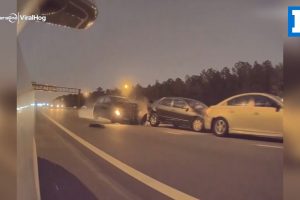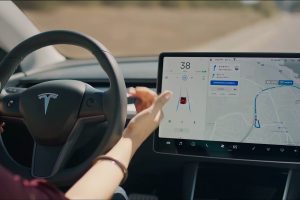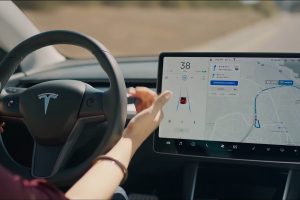Tesla Vision, the electric automaker’s radar-less and camera-based Autopilot approach, is improving significantly with each software update the company releases. New videos from an owner who has regularly tested the performance of Tesla Autopilot in heavy rain conditions show the vehicle is operating more confidently and with increased precision thanks to improvements released by Tesla.
Kevin Smith, known as @Spleck online, has been regularly using Autopilot in his Tesla Model Y in rainy conditions to test the vehicle’s performance in tough weather with the camera-based approach the company shifted to a few months ago. In May, Tesla announced the adoption of Tesla Vision, stating that it would permanently remove radar from the Model 3 and Model Y, using only cameras to operate Autopilot and FSD. It was a long-awaited move for Tesla and CEO Elon Musk, who saw the use of radar as a crutch for the camera system to operate more accurately. Eventually, Tesla will move the Model S and Model X to the camera-only system as well. For now, it only applies to Model 3 and Model Y vehicles.
The vehicle regularly reduced speed due to heavy rainfall and decreased visibility, a normal reaction from the camera-based approach and even some human drivers in tough conditions. However, the vehicle was reducing speed to an uncomfortable and frustrating amount. Smith explains that previous software versions were too timid and lacked confidence in heavy rain conditions. Software version 2021.4.18.1, which was released in June, was the first instance where Smith realized his vehicle was slowing down at an increased rate due to the excessive rainfall, alerting the driver with a message that read “Speed Limited for Visibility.” Eventually, Smith was kicked out of Autopilot by the vehicle due to visibility issues.
There were still persisting issues with July’s 2021.4.18.10 release, although the Model Y could stay in Autopilot with the rain. However, there was a fairly drastic decrease in speed even though Autopilot stayed active during the drive. The speed reduction was reported even in “moderate rain,” Smith said.
August’s 2021.4.21.3 update was the most impressive to date, Smith said. Autopilot is reacting much more confidently in even heavy rainfall, drastically improving from the heavy speed reductions that were encountered in previous versions.
Tesla Autopilot and Full Self-Driving improve with every software update thanks to the company’s neural network, which compiles data after every mile driven. Tesla has billions of miles of data that continue to improve the vehicle’s performance in tough weather conditions and challenging driving scenarios. The improvements with driving in the rain are evident. Tesla’s camera-based approach for the Model 3 and Model Y is evidently becoming more confident with the additional data and experience the cars are compiling.
Tesla Vision is also expanding to other features, like Autopark, as radar will eventually be completely phased out from the company’s vehicles.
Check out Kevin Smith’s video below.





